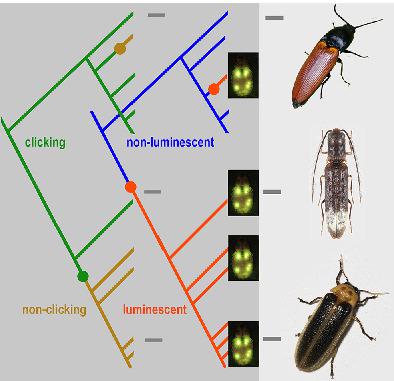当前位置:
X-MOL 学术
›
Syst. Entomol.
›
论文详情
Our official English website, www.x-mol.net, welcomes your
feedback! (Note: you will need to create a separate account there.)
Phylogenomic relationships of bioluminescent elateroids define the ‘lampyroid’ clade with clicking Sinopyrophoridae as its earliest member
Systematic Entomology ( IF 4.7 ) Pub Date : 2020-08-25 , DOI: 10.1111/syen.12451 Dominik Kusy 1 , Jin‐Wu He 2 , Seth M. Bybee 3 , Michal Motyka 1 , Wen‐Xuan Bi 2 , Lars Podsiadlowski 4 , Xue‐Yan Li 2 , Ladislav Bocak 1
Systematic Entomology ( IF 4.7 ) Pub Date : 2020-08-25 , DOI: 10.1111/syen.12451 Dominik Kusy 1 , Jin‐Wu He 2 , Seth M. Bybee 3 , Michal Motyka 1 , Wen‐Xuan Bi 2 , Lars Podsiadlowski 4 , Xue‐Yan Li 2 , Ladislav Bocak 1
Affiliation

|
Bioluminescence has been hypothesized as aposematic signalling, intersexual communication and a predatory strategy, but origins and relationships among bioluminescent beetles have been contentious. We reconstruct the phylogeny of the bioluminescent elateroid beetles (i.e. Elateridae, Lampyridae, Phengodidae and Rhagophthalmidae), analysing genomic data of Sinopyrophorus Bi & Li, and in light of our phylogenetic results, we erect Sinopyrophoridae Bi & Li, stat.n. as a clicking elaterid‐like sister group of the soft‐bodied bioluminescent elateroid beetles, that is, Lampyridae, Phengodidae and Rhagophthalmidae. We suggest a single origin of bioluminescence for these four families, designated as the ‘lampyroid clade’, and examine the origins of bioluminescence in the terminal lineages of click beetles (Elateridae). The soft‐bodied bioluminescent lineages originated from the fully sclerotized elateroids as a derived clade with clicking Sinopyrophorus and Elateridae as their serial sister groups. This relationship indicates that the bioluminescent soft‐bodied elateroids are modified click beetles. We assume that bioluminescence was not present in the most recent common ancestor of Elateridae and the lampyroid clade and it evolved among this group with some delay, at the latest in the mid‐Cretaceous period, presumably in eastern Laurasia. The delimitation and internal structure of the elaterid‐lampyroid clade provides a phylogenetic framework for further studies on the genomic variation underlying the evolution of bioluminescence.
中文翻译:

生物发光elateroids的系统发育关系定义了'lampyroid'进化枝,点击Sinopyrophoridae作为其最早成员
生物发光被假设为隐喻信号、两性交流和掠夺性策略,但生物发光甲虫之间的起源和关系一直存在争议。我们重建了生物发光甲虫(即Elateridae、Lampyridae、Phengodidae 和Rhagophthalmidae)的系统发育,分析了Sinopyrophorus Bi & Li 的基因组数据,并根据我们的系统发育结果,我们建立了Sinopyrophoridae Bi & Li,stat.n。作为软体生物发光甲虫的一个类似弹性甲虫的姐妹群,即 Lampyridae、Phengodidae 和 Rhagophthalmidae。我们建议将这四个家族的单一生物发光起源称为“灯蛾进化枝”,并检查点击甲虫(Elateridae)终末谱系中生物发光的起源。软体生物发光谱系起源于完全硬化的 elateroids 作为派生的进化枝,点击 Sinopyrophorus 和 Elateridae 作为它们的连续姐妹群。这种关系表明生物发光的软体 elateroids 是改良的点击甲虫。我们假设 Elateridae 和灯状体进化枝的最新共同祖先中不存在生物发光,并且它在这个群体中进化有一定的延迟,最迟在白垩纪中期,大概是在东劳亚大陆。elaterid-lampyroid进化枝的界限和内部结构为进一步研究生物发光进化背后的基因组变异提供了系统发育框架。
更新日期:2020-08-25
中文翻译:

生物发光elateroids的系统发育关系定义了'lampyroid'进化枝,点击Sinopyrophoridae作为其最早成员
生物发光被假设为隐喻信号、两性交流和掠夺性策略,但生物发光甲虫之间的起源和关系一直存在争议。我们重建了生物发光甲虫(即Elateridae、Lampyridae、Phengodidae 和Rhagophthalmidae)的系统发育,分析了Sinopyrophorus Bi & Li 的基因组数据,并根据我们的系统发育结果,我们建立了Sinopyrophoridae Bi & Li,stat.n。作为软体生物发光甲虫的一个类似弹性甲虫的姐妹群,即 Lampyridae、Phengodidae 和 Rhagophthalmidae。我们建议将这四个家族的单一生物发光起源称为“灯蛾进化枝”,并检查点击甲虫(Elateridae)终末谱系中生物发光的起源。软体生物发光谱系起源于完全硬化的 elateroids 作为派生的进化枝,点击 Sinopyrophorus 和 Elateridae 作为它们的连续姐妹群。这种关系表明生物发光的软体 elateroids 是改良的点击甲虫。我们假设 Elateridae 和灯状体进化枝的最新共同祖先中不存在生物发光,并且它在这个群体中进化有一定的延迟,最迟在白垩纪中期,大概是在东劳亚大陆。elaterid-lampyroid进化枝的界限和内部结构为进一步研究生物发光进化背后的基因组变异提供了系统发育框架。











































 京公网安备 11010802027423号
京公网安备 11010802027423号